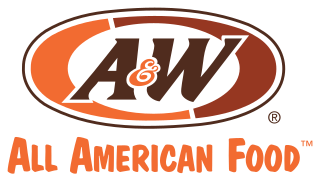
A fast-food restaurant, also known as a quick-service restaurant (QSR) within the industry, is a specific type of restaurant that serves fast-food cuisine and has minimal table service. The food served in fast-food restaurants is typically part of a "meat-sweet diet", offered from a limited menu, cooked in bulk in advance and kept hot, finished and packaged to order, and usually available for take away, though seating may be provided. Fast-food restaurants are typically part of a restaurant chain or franchise operation that provides standardized ingredients and/or partially prepared foods and supplies to each restaurant through controlled supply channels. The term "fast food" was recognized in a dictionary by Merriam–Webster in 1951.

A&W Restaurants is an American fast food restaurant chain distinguished by its burgers, draft root beer and root beer floats. Being the oldest restaurant chain in America, A&W's origins date back to 1919 when Roy W. Allen set up a roadside drink stand to offer a new thick and creamy drink, root beer, at a parade honoring returning World War I veterans in Lodi, California. Allen's employee Frank Wright partnered with him in 1922 and they founded their first restaurant in Sacramento, California in 1923. The company name was taken from the initials of their last names – Allen and Wright. The company became famous in the United States for its "frosty mugs" – the mugs were kept in a freezer and filled with A&W Root Beer just before being served to customers.

Fast food is a type of mass-produced food designed for commercial resale, with a strong priority placed on speed of service. It is a commercial term, limited to food sold in a restaurant or store with frozen, preheated or precooked ingredients and served in packaging for take-out/take-away. Fast food was created as a commercial strategy to accommodate large numbers of busy commuters, travelers and wage workers. In 2018, the fast food industry was worth an estimated $570 billion globally.
The Arch Deluxe was a hamburger sold by the international fast food restaurant chain McDonald's in 1996 and marketed specifically to adults. It was soon discontinued after failing to become popular despite a massive marketing campaign and now is considered one of the most expensive flops of all time.

Digital signage is a segment of electronic signage. Digital displays use technologies such as LCD, LED, projection and e-paper to display digital images, video, web pages, weather data, restaurant menus, or text. They can be found in public spaces, transportation systems, museums, stadiums, retail stores, hotels, restaurants and corporate buildings etc., to provide wayfinding, exhibitions, marketing and outdoor advertising. They are used as a network of electronic displays that are centrally managed and individually addressable for the display of text, animated or video messages for advertising, information, entertainment and merchandising to targeted audiences.
Mobile marketing is a multi-channel online marketing technique focused at reaching a specific audience on their smartphones, feature phones, tablets, or any other related devices through websites, e-mail, SMS and MMS, social media, or mobile applications. Mobile marketing can provide customers with time and location sensitive, personalized information that promotes goods, services, appointment reminders and ideas. In a more theoretical manner, academic Andreas Kaplan defines mobile marketing as "any marketing activity conducted through a ubiquitous network to which consumers are constantly connected using a personal mobile device".

BK Chicken Fries are a fried chicken product sold by the international fast-food restaurant chain Burger King. At the time of their introduction in 2005, the company had intended Chicken Fries to be one of their larger, adult-oriented products made with higher-quality ingredients than their standard menu items. Additionally, the product further targeted the snacking and convenience food markets with a specific packaging design that was intended to be easier to handle and fit into automotive cup holders. The product was part of a series of product introductions designed to expand Burger King's menu with both more sophisticated fare and present a larger, meatier product that appealed to 24- to 36-year-old males. Along with this series of larger, more complex menu products, the company intended to attract a larger, more affluent adult audience who would be willing to spend more on the better-quality products. They were discontinued in the United States in 2012, but continued to be sold in some markets, such as Italy. In August 2014, they were reintroduced for a limited-time offering (LTO) in North America, leading to their permanent re-addition to the menu in March 2015 in over 30 countries globally.
Restaurants fall into several industry classifications, based upon menu style, preparation methods and pricing, as well as the means by which the food is served to the customer. This article mainly describes the situation in the US, while categorisation differs widely around the world.
When the predecessor of international fast food restaurant chain Burger King (BK) first opened in 1953, its menu predominantly consisted of hamburgers, French fries, soft drinks, milkshakes, and desserts. After being acquired by its Miami, Florida franchisees and renamed in 1954, BK began expanding its menu by adding the Whopper sandwich in 1957, and has since added non-beef items such as chicken, fish, and vegetarian offerings, including salads and meatless sandwiches. Other additions include a breakfast menu and beverages such as Icees, juices, and bottled waters. As the company expanded both inside and outside the United States, it introduced localized versions of its products that conform to regional tastes and cultural or religious beliefs. To generate additional sales, BK occasionally introduces limited-time offers of special versions of its products, or brings out completely new products intended for either long- or short-term sales. Not all of these products and services have been successful; in 1992, Burger King introduced limited table service featuring special dinner platters, but this concept failed to generate interest and was discontinued.

Social media marketing is the use of social media platforms and websites to promote a product or service. Although the terms e-marketing and digital marketing are still dominant in academia, social media marketing is becoming more popular for both practitioners and researchers. Most social media platforms have built-in data analytics tools, enabling companies to track the progress, success, and engagement of ad campaigns. Companies address a range of stakeholders through social media marketing, including current and potential customers, current and potential employees, journalists, bloggers, and the general public. On a strategic level, social media marketing includes the management of a marketing campaign, governance, setting the scope and the establishment of a firm's desired social media "culture" and "tone."

Disposable food packaging comprises disposable products often found in fast food restaurants, takeout restaurants and kiosks, and catering establishments. Food-serving items for picnics and parties are very similar. Typical disposable foodservice products are foam food containers, plates, bowls, cups, utensils, doilies and tray papers. These products can be made from a number of materials including plastics, paper, bioresins, wood and bamboo.

Smashburger IP Holder LLC, doing business as Smashburger,, is an American fast-casual hamburger restaurant chain founded in Denver, Colorado. As of 2022, it has more than 227 corporate and franchise-owned restaurants in 35 U.S. states and the District of Columbia and 2 Canadian provinces.
Urbanspoon was a restaurant information and recommendation service founded in 2006 by former Jobster employees that offered its services in North America and parts of English-speaking Australasia and Europe. In January 2015, Zomato, an India-based restaurant search and discovery service, acquired Urbanspoon.
Zomato (/zoʊˈmætɔː/) is an Indian multinational restaurant aggregator and food delivery company, founded by Deepinder Goyal and Pankaj Chaddah in 2008. Zomato provides information, menus and user-reviews of restaurants as well as food delivery options from partner restaurants in more than 1,000 Indian cities, as of 2022.
Grubhub Inc. is an American online and mobile prepared food ordering and delivery platform. The company is based in Chicago, Illinois.

Western-style fast food in mainland China is a fairly recent phenomenon, with Kentucky Fried Chicken (KFC) establishing its first Beijing restaurant in November 1987. This location was met with unprecedented success, and served as a model for many local Chinese restaurants that followed it.

KFC is a fast-food restaurant chain founded by Colonel Harland Sanders in Salt Lake City, Utah, in 1952. KFC specializes in selling fried chicken and is known to have diversified the fast-food market by challenging the dominance of the chicken burger. In 1930, at the age of 40 Colonel Sanders bought a roadside motel in Corbin, Kentucky to sell his southern style chicken. By 1939, he had created his blend of 11 herbs and spices that are still used in the recipes today. In 1950, the colonel became an icon by regularly wearing his white suit in public. 1952 marks the opening of the first Kentucky Fried Chicken franchise in Salt Lake City, Utah. In 1957, the original KFC bucket became recognized worldwide. Due to the rapid growth of KFC, Colonel Sanders sold his company to a group of investors in 1964 and moved to Canada for the remainder of his life.

Retail food delivery is a courier service in which a restaurant, store, or independent food-delivery company delivers food to a customer. An order is typically made either through a restaurant or grocer's website or mobile app, or through a food ordering company. The delivered items can include entrees, sides, drinks, desserts, or grocery items and are typically delivered in boxes or bags. The delivery person will normally drive a car, but in bigger cities where homes and restaurants are closer together, they may use bikes or motorized scooters.
Brightloom is an American company based in San Francisco that provides automation technology to restaurants. Both Eatsa and Brightloom are trade names used by Keenwawa, Inc., a Delaware corporation, which is the true legal name of this company.
Uber Eats is an online food ordering and delivery platform launched by Uber in 2014. Meals are delivered by couriers using cars, scooters, bikes, or on foot. It is operational in over 6,000 cities across 45 countries as of 2021.











